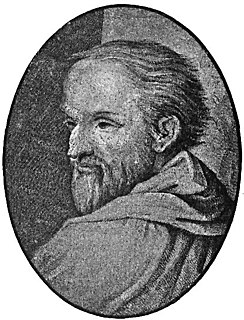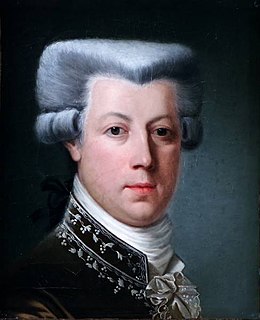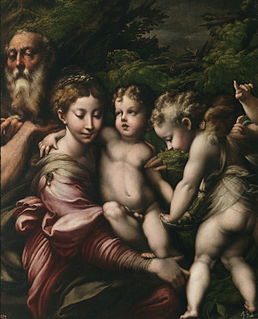
Antonio Allegri da Correggio, usually known as just Correggio, was the foremost painter of the Parma school of the High Italian Renaissance, who was responsible for some of the most vigorous and sensuous works of the sixteenth century. In his use of dynamic composition, illusionistic perspective and dramatic foreshortening, Correggio prefigured the Baroque art of the seventeenth century and the Rococo art of the eighteenth century. He is considered a master of chiaroscuro.

Annibale Carracci was an Italian painter and instructor, active in Bologna and later in Rome. Along with his brother and cousin, Annibale was one of the progenitors, if not founders of a leading strand of the Baroque style, borrowing from styles from both north and south of their native city, and aspiring for a return to classical monumentality, but adding a more vital dynamism. Painters working under Annibale at the gallery of the Palazzo Farnese would be highly influential in Roman painting for decades.

Domenico di Pace Beccafumi was an Italian Renaissance-Mannerist painter active predominantly in Siena. He is considered one of the last undiluted representatives of the Sienese school of painting.

Girolamo Francesco Maria Mazzola, also known as Francesco Mazzola or, more commonly, as Parmigianino, was an Italian Mannerist painter and printmaker active in Florence, Rome, Bologna, and his native city of Parma. His work is characterized by a "refined sensuality" and often elongation of forms and includes Vision of Saint Jerome (1527) and the iconic if somewhat anomalous Madonna with the Long Neck (1534), and he remains the best known artist of the first generation whose whole careers fall into the Mannerist period.

Museo di Capodimonte is an art museum located in the Palace of Capodimonte, a grand Bourbon palazzo in Naples, Italy. The museum is the prime repository of Neapolitan painting and decorative art, with several important works from other Italian schools of painting, and some important ancient Roman sculptures. It is one of the largest museums in Italy. The museum was inaugurated in 1957.

Francesco de' Rossi was an Italian Mannerist painter who lived and worked mainly in Florence, but also produced several works in Rome. He is known by many names, prominently the adopted name Francesco Salviati or as Il Salviati, but also Francesco Rossi and Cecchino del Salviati.

The mystical marriage of Saint Catherine covers two different subjects in Christian art arising from visions received by either Catherine of Alexandria or Catherine of Siena (1347–1380), in which these virgin saints went through a mystical marriage wedding ceremony with Christ, in the presence of the Virgin Mary, consecrating themselves and their virginity to him.

Luigi Braschi Onesti, duca di Nemi, was a nephew of Pope Pius VI, who granted him his dukedom.

Portrait of Galeazzo Sanvitale (1524) is a painting of the condottiero Gian Galeazzo Sanvitale by the Italian late Renaissance artist Parmigianino. It is housed in the National Museum of Capodimonte, Naples, Italy.

The Galleria nazionale di Parma is an art gallery in Parma, northern Italy.

The Bardi Altarpiece, is an Italian Mannerist painting by the Italian painter Parmigianino, dating from c. 1521 and housed in the church of Santa Maria at Bardi, Emilia-Romagna, Italy.

The Mystic Marriage of Saint Catherine is a painting by Correggio dating about the mid-1520s currently held and exhibited at the Louvre in Paris, France.
(The) Mystic(al) Marriage of Saint/St. Catherine may refer to any of a large number of paintings of the Mystical marriage of Saint Catherine, a few of which are:

The Mystic Marriage of St Catherine is a c.1529 oil on panel painting of the mystical marriage of Saint Catherine by Parmigianino, now in the National Gallery, London, who acquired it in 1974. It was engraved by Giulio Bonasone.

Holy Family with the Infant Saint John the Baptist is a painting by Parmigianino, executed c. 1528. It was in the Palazzo Farnese in Rome until 1662, when it moved to Parma. There it hung in the Palazzo del Giardino and later in the Galleria Ducale - the 'Descrizione' of the latter in 1725 called it one of the finest works on display there. It and the rest of the Farnese collection were later moved to Naples and the work was exhibited for a few years in the Palazzo Reale before moving to its present home in the National Museum of Capodimonte. Two early copies remain in the Galleria Nazionale and Palazzo Comunale in Parma.

Mystic Marriage of Saint Catherine or Mystic Betrothal of Saint Catherine is a c.1524 oil on canvas painting by the Italian Renaissance painter Parmigianino. The work is now in the Galleria nazionale di Parma. Art historians argue that the work may be attributed to the period in which Parmigianino was painting his first works in the church of San Giovanni Evangelista, as also emerges from a recent restoration, which has shown that its technique is near-identical to that of Parmigianino - "no underdrawing, pigment use, descriptive speed, drafting of final shadows, using fingers and brush-ends as tools".

Portrait of a Man in a Red Beret or Self-Portrait in a Red Beret is an oil on paper painting attributed to Parmigianino or Michelangelo Anselmi, executed c. 1540, now in the collection of the National Gallery of Parma.

Saint Roch is a tempera on canvas painting by Parmigianino, executed c. 1528, now in a private collection in Parma. It measures 27.8 by 21.5 cm. A preparatory study for the work survives in the Bonnat Museum in Bayonne. Like the artist's Saint Roch with a Donor (1527), its elongated figures are typical of works produced during his stay in Bologna after escaping the Sack of Rome.

The Holy Family with Angels is an oil painting on panel of c. 1524 by Parmigianino in the Museo del Prado in Madrid.

The Sanvitale Madonna and Child is a 1524 fragment of a lunette fresco by Parmigianino at the Palazzetto Eucherio Sanvitale in Parma. It is heavily influenced by Correggio, particularly quoting his Madonna of the Stairs. It dates to just before Parmigianino set off for Rome in 1525, particularly by comparing it with his other works from that period such as his Diana and Actaeon frescoes at Rocca di Fontanellato. Preparatory drawings for the work survive in the British Museum's Department of Prints and Drawings, the Cabinet des Dessins at the Louvre and a private collection.



















